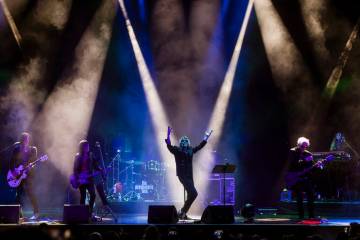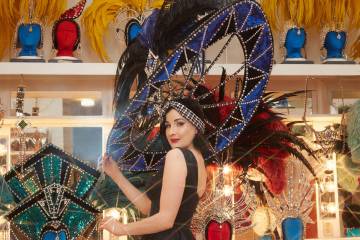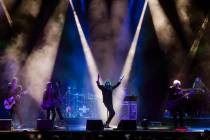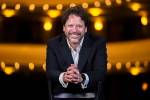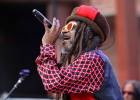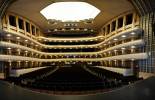Philharmonic presents the oove, a strange, one-of-a-kind instrument
Get into the OOVE.
That’s exactly what the Las Vegas Philharmonic will do for the world premiere of composer Nathaniel Stookey’s “Yield to Total Elation” Saturday at The Smith Center.
During the premiere, the composer himself will play the OOVE, a one-of-a-kind electro-acoustic stringed instrument created by kinetic sculptor Oliver DiCicco.
The OOVE’s name was inspired, DiCicco says, by its resemblance to an upright Hoover vacuum cleaner.
He likens its sound, “in pure drone form” to an Indian tambura.
But “with the handheld pickup” Stookey will employ during Saturday’s concert, DiCicco describes the OOVE’s sound as “more like Jimi Hendrix.”
That matches Stookey’s assessment of its sound: “a little bit like an overdriven electric guitar, at times.”
But it’s not plucked or strummed, he notes. Instead, “it begins with a very quiet drone.”
The instrument’s four strings have slides that allow the pitches to go from high to low, “as well as tuning keys, which I also use,” the composer explains, adding that “I’m not an OOVE virtuoso.”
Then again, he doesn’t need to be.
Despite its unique look and sound, the OOVE is only a supporting player in “Yield to Total Elation.”
Indeed, it’s entirely possible to perform the work without an OOVE, he adds, but the sound and particularly the harmonies the OOVE creates set up this harmonic background that the orchestra “picks up and runs with.”
Philharmonic music director Donato Cabrera agrees, calling the OOVE “only a backdrop to accompany the amazing sounds of the orchestra.”
Saturday’s concert marks the second time Stookey will play the OOVE during “Yield to Total Elation.” The first time occurred last April, when the chamber orchestra version — commissioned by the San Francisco Symphony — debuted in the orchestra’s SoundBox, an “immersive sound environment.”
Then again, “a symphony orchestra creates an immersive sound on its own,” the composer adds.
Stookey discovered DiCicco’s work through the artist’s kinetic sound sculpture “Sirens,” then ran into him at a party where he learned that DiCicco also made instruments. (You can see some of DiCicco’s other musical creations, from “Big Marimba” to “Olivetti,” online at oliverdicicco.com.)
DiCicco was in turn inspired by 1950s composer and instrument builder Harry Partch, whom the artist discovered during his 1970s college years.
“The thought that someone could build an entire orchestra of instruments really resonated with me,” DiCicco says.
So he began building, creating one-of-a-kind pieces that DiCicco and colleagues played in their own performance ensemble.
Stookey moved several of the instruments into his studio, “to play with,” and thought about how to use them.
When the San Francisco Symphony commissioned him to write something for SoundBox, the composer thought it would be “a perfect place” — and started experimenting with various DiCicco creations. “The OOVE ended up being the one that sparked the piece.”
Along with the visionary drawings of A.G. Rizzoli, a draftsman who created elaborate designs for a vast imaginary city.
“I saw an article about his work,” focusing on “a city (Rizzoli) called ‘Yield to Total Elation,’ ” Stookey recalls. “I thought, wow, that’s how I want music to feel, always,” prompting his quest to “make a piece that strives for that.”
Stookey’s 20-minute piece creates “a soundscape,” Cabrera says, noting the composer’s firm grasp of “melody and harmony,” as well as “ an incredible palette of sounds only Nat can create.”
In short, it’s “an orchestral showpiece by a living American composer,” Cabrera says — something that’s been a hallmark of his tenure as the Philharmonic’s music director.
“Yield to Total Elation” isn’t the only piece by a living American composer on Saturday’s program, however.
In its West Coast premiere, Clarice Assad’s overture “Nhanderu” paints a musical portrait of an Amazon basin ritual.
“Her music is so evocative — always, she finds a way to incorporate Brazilian rhythms,” says Cabrera, who also notes Assad’s “fantastic performing career as a scat singer and jazz pianist.” (Music runs in the family; her father Sergio and uncle Odair are the guitar virtuosos collectively known as the Assad Brothers.)
Cabrera’s commitment to program music by living composers reflects the hope that “the audience has known me for a couple of years and trusts me enough to go on an exploration,” he explains.
That sense of exploration also extends to lesser-known works by legendary composers — including Antonin Dvorak’s Symphony No. 7 in D Minor, which rounds out Saturday’s program.
One of Cabrera’s favorites, Dvorak’s seventh symphony belongs “in the pantheon of great symphonies, but it’s not often performed,” in part because “it’s quite difficult” for the musicians to play, he says. Besides, “everyone wants to hear the ‘New World.’ ” (Dvorak’s ninth, and most famous, symphony will be on the Philharmonic’s schedule in a couple of years, Cabrera notes.)
Overall, “what this concert will reveal,” the conductor says, “is three very intriguing pieces by amazing composers — and two live in the U.S. right now.”
Read more from Carol Cling at reviewjournalcom. Contact her at ccling@reviewjournal.com and follow @CarolSCling on Twitter.
PREVIEW
What: Las Vegas Philharmonic
When: 7:30 p.m. Saturday; pre-concert talk at 6:30 p.m.
Where: Reynolds Hall, The Smith Center for the Performing Arts, 361 Symphony Park Ave.
Tickets: $30-$109 (702-749-2000, www.thesmithcenter.com)






